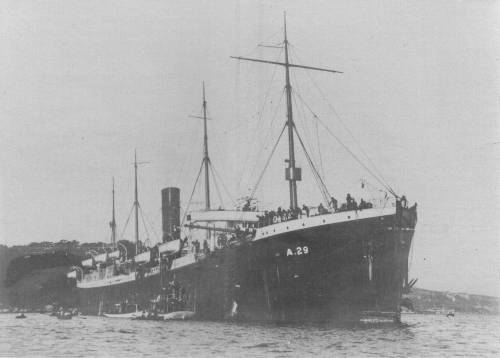- Author
- Date, John C., RANVR (Rtd)
- Subjects
- Ship histories and stories, History - WW1, WWI operations
- Tags
-
- RAN Ships
- None noted.
- Publication
- June 1989 edition of the Naval Historical Review (all rights reserved)

The above interesting photo of the troopship S.S. SUEVIC, which appears to have been taken in SydneyHarbour, was held by George Hancock, formerly of SydneyHigh School and who was probably a member of the 12th Regiment of the Australian Light Horse of the first AIF, departing for the European War in 1915.
Australian troops aboard can be identified by their slouch hats and no doubt the deck structures in the centre aft section are the stables for the horses. It was the practice for mounted troops to travel in company with their horses which involved everyday duties of rubbing down the horses, cleaning the stables and exercising the horses in a suitable deck space which would have been covered by sand and ash. This work excused the men from the need to undertake otherwise routine athletic exercises, for these arduous duties assured that the mounted trooper would have himself and his horse fit and able for service immediately upon disembarkation in Egypt!
Later in the war, most of these troopships were dazzle painted for camouflage which gave great protection from submarine attack in particular.
Our Society member Norman Rivett has researched the following history of the ship. The White Star Line steamer SUEVIC, of 12,531 tons, was built at Belfast in 1900 by Harland and Wolff, the Line’s traditional shipbuilders. The ship was intended for the Australian trade and although primarily a cargo carrier, accommodation was available for in excess of 400 third class passengers. All the White Star characteristics were present in SUEVIC, clean simple lines, straight stem, counter stern, and four tall raked masts which were a feature of all the company’s ships long after there was need for even steadying canvas, and which continued until the advent of the OLYMPIC in 1911.
On 17 March 1907 whilst homeward bound with a cargo of Australian primary products, SUEVIC ran aground on Stag Rock, ten miles NE of the Lizard, at the entrance to the English Channel. The cargo was salvaged but the ship remained hard and fast on the rocks defying all efforts to refloat her. In desperation the ship was split in two by the use of explosives, and the section just aft of the bridge floated free and towed initially to nearby Plymouth and later to Southampton. A new bow section was built at her original builder’s yard and towed to Southampton where it was joined to the surviving stern section.
SUEVIC resumed her regular service until the advent of WW I, when she and her sister ship RUNIC were taken over as troopships. On completion of trooping duties SUEVIC again returned to her regular route until 1928, when she was sold to Norwegian owners and converted into a whaling factory ship and renamed SKYTTEREN. During WW II, whilst attempting to escape from the Baltic, the SKYTTEREN was intercepted by the Kriegsmarine on 1 April, 1942.
Rather than allow their ship to be captured, the Norwegian crew scuttled her. Can any member of our Society offer further information about this picture?




